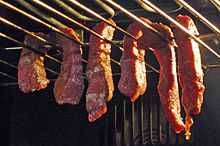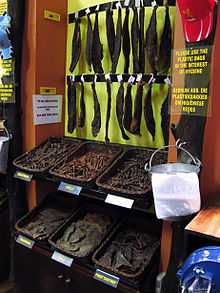Biltong


Biltong is a variety of dried, cured meat that originated in Southern Africa. Various types of meat are used to produce it, ranging from beef and game meats to fillets of ostrich from commercial farms. It is typically made from raw fillets of meat cut into strips following the grain of the muscle, or flat pieces sliced across the grain. It is similar to beef jerky in that they are both spiced, dried meats. The typical ingredients, taste and production processes differ, the main difference being that biltong is dried and subsequently sliced whereas jerky is sliced prior to drying.
The word biltong is from the Dutch bil ("rump") and tong ("strip" or "tongue").[1]
Origins
Indigenous peoples of Southern Africa, such as the Khoikhoi, preserved meat by slicing it into strips, curing it with salt, and hanging it up to dry. After European settlers (Dutch, German, French) arrived in southern Africa in the early 17th century, they improved the curing process by using vinegar, saltpetre and spices including pepper, coriander and cloves.[2]
The need for preservation in the new colony was pressing. Building up herds of livestock took a long time but with indigenous game in abundance, traditional methods were available to preserve large masses of meat such as found in the eland in a hot climate. Iceboxes and fridges had not been invented yet. Biltong as it is today evolved from the dried meat carried by the wagon-travelling Voortrekkers, who needed stocks of durable food as they migrated from the Cape Colony north and north-eastward (away from British rule) into the interior of Southern Africa during the Great Trek. The meat was preserved and hung to be dried for a fortnight after which it would be ready for packing in cloth bags.
Ingredients
The most common ingredients of biltong are:[3][4]
- Meat
- Black pepper
- Coriander
- Salt
- Sugar or Brown sugar
- Vinegar
Modern-day ingredients sometimes added include: balsamic vinegar or malt vinegar, dry ground chili peppers, nutmeg, garlic, bicarbonate of soda, Worcestershire sauce,[5] onion powder, and saltpetre.
Meat
Prior to the introduction of refrigeration, the curing process was used to preserve all kinds of meat in South Africa. However today biltong is most commonly made from beef, primarily because of its widespread availability and lower cost relative to game. For the finest cuts, fillet, sirloin or steaks cut from the hip such as topside or silverside. Other cuts can be used, but are not as high in quality.
Biltong can also be made from:
- Chicken, simply referred to as 'chicken biltong'
- Fish in this case, known as bokkoms (shark biltong can also be found in South Africa).[6][7]
- Game such as kudu and springbok
- Ostrich meat (bright red, often resembling game)
Bokkoms should not be confused with other cured fish such as dried angelfish and dried snoek.
Preparation
Ideally the meat is marinated in a vinegar solution (grape vinegar is traditional but balsamic and cider also works very well) for a few hours, this being finally poured off before the meat is flavoured.
The spice mix traditionally consists of equal amounts of: rock salt, barbecue spice, whole coriander slightly roasted and roughly ground, black pepper and brown sugar.[8] This mix is then ground roughly together, sprinkled liberally over the meat and rubbed in. Saltpetre is optional and can be added as an extra preservative (necessary only for wet biltong that is not going to be frozen).
The meat should then be left for a further few hours (or refrigerated overnight) and any excess liquid poured off before the meat is hung in the dryer.
Drying

It is typically dried out in the cold air (rural settings), cardboard or wooden boxes (urban) or climate-controlled dry rooms (commercial). Depending on the spices used, a variety of flavours may be produced. Biltong can also be made in colder climates by using an electric lamp to dry the meat, but care must be taken to ventilate, as mold can begin to form on the meat.
A traditional slow dry will deliver a medium cure in about 4 days.
An electric fan-assisted oven set to 40–70 °C (100–160 °F), with the door open a fraction to let out moist air, can dry the meat in approximately 4 hours. Although slow dried meat is considered by some to taste better, oven dried is ready to eat a day or two after preparation.
Comparison to jerky
.jpg)
Biltong differs from jerky in three distinct ways:
- The meat used in biltong can be much thicker; typically biltong meat is cut in strips approx 1" (25 mm) wide – but can be thicker. Jerky is normally very thin meat.
- The vinegar, salt and spices in biltong, together with the drying process, cure the meat as well as adding texture and flavour. Jerky is traditionally dried with salt but without vinegar.
- Jerky is often smoked; biltong is never smoked.
Retail

Biltong is a common product in Southern African butcheries and grocery stores, and can be bought in the form of wide strips (known as stokkies, meaning "little sticks"). It is also sold in plastic bags, sometimes shrink-wrapped, and may be either finely shredded or sliced as biltong chips.
There are also specialised retailers that sell biltong. These shops may sell biltong as "wet" (moist), "medium" or "dry". Additionally, some customers prefer it with a lot of fat within the muscle fibres, while others prefer it as lean as possible.
Eating
While biltong is usually eaten as a snack, it can also be diced up into stews, or added to muffins or pot bread. Biltong-flavoured potato crisps have also been produced,[9] and there are cheese spreads[10][11] with biltong flavour. Finely shredded biltong is eaten on slices of bread and in sandwiches.[12][13]
Biltong can be used as a teething aid for babies.[14] Some retail stores offer a mild form of biltong especially for this purpose which does not contain the spices used for flavouring.
Biltong is a high protein food. Often, 200g of beef is required to make 100g of biltong, and the process of making biltong preserves most of the protein content. Some biltong can have up to 67% protein content per 100g of biltong,[15] which is about double what other dried meats like beef jerky have.
Biltong worldwide

Biltong's popularity has spread to many other countries, notably Canada, the United Kingdom, Australia, New Zealand and now India which have large South African populations, and also to the United States. Biltong is also produced within South African expatriate communities across the globe, for example in Germany and even South Korea.
Biltong produced in South Africa may not be imported into Britain, according to rules governing the importation of meat-based products from non-EU countries laid down by HM Customs and Excise and its successor HM Revenue and Customs,[16] thus it is made in the UK.
See also
Similar foods
Foods similar to biltong include:
See also
References
- ↑ Eric Partridge (20 September 2006). Origins: An Etymological Dictionary of Modern English. Routledge. ISBN 978-0-203-42114-7. Retrieved 2008-09-24.
- ↑ Beinart, William. The Rise of Conservation in South Africa. Oxford University Press.
- ↑ Rockland, Louis B.; Beuchat, Larry R. (1987). "Intermediate Moister Foods". Water Activity: Theory and Applications to Food. CRC Press. p. 318. ISBN 978-0-8247-7759-3. Retrieved 2008-09-29.
- ↑ Arora, Dilip K.; Arora, Bharat Rai (1991). "Xerophilic Fungi in Intermediate and Low Moisture Foods". Handbook of Applied Mycology. CRC Press. p. 74. ISBN 978-0-8247-8491-1. Retrieved 2008-09-29.
- ↑ Madikwa, Zenoyise (25 September 2008). "Making biltong is really simple". The Sowetan. Retrieved 2008-09-29.
- ↑ Wylie, Diana (2001). Starving on a Full Stomach: Hunger and the Triumph of Cultural Racism in Modern South Africa. University of Virginia Press. p. 83. ISBN 978-0-8139-2068-9. Retrieved 2008-09-23.
Sometimes the food donated as famine relief were memorably bizarre, and surprisingly popular, such as shark biltong (dried shark meat).
- ↑ Heemstra, Elaine (2004). Coastal Fishes of Southern Africa. NISC (PTY) Ltd. pp. 63–64. ISBN 978-1-920033-01-9. Retrieved 2008-09-23.
[T]he meat [of the soupfin shark] is dried, salted and sold as shark biltong.
- ↑ d’Amato, Maria Eugenia; Alechine, Evguenia; Cloete, Kevin Wesley; Davison, Sean; Corach, Daniel (2013). "Where is the game? Wild meat products authentication in South Africa: A case study". Investigative Genetics 4 (1): 6. doi:10.1186/2041-2223-4-6. PMC 3621286. PMID 23452350.
- ↑ Examine the World Snack Foods Markets, Reportlinker.com, 29 April 2008, retrieved 2008-09-29,
Simba Launches Lay's Potato Chips in Biltong Flavor
- ↑ http://www.clover.co.za/product-view/360/processed-cheese-slices-biltong
- ↑ http://www.saffatrading.co.za/pMEL001/Melrose-Cheese-Spread.aspx
- ↑ http://www.biltongparadise.co.za/index.php/24-biltong-gallery
- ↑ http://www.biltongshopper.com/biltongrecipes.html
- ↑ Boase, Tessa (10 January 2005). "African snackshot". The Daily Telegraph (London). Retrieved 2008-09-29.
[Biltong is] particularly good for teething babies
- ↑ "Billy Franks Beef Jerky - Roast Beef and Mustard (40g)". MeatSnacker. Retrieved 28 March 2015.
- ↑ HMRC. "FAQ: Meat, food and plants". Her Majesty's Customs and Excise. Archived from the original on 2 February 2009. Retrieved 2007-09-10.
| Wikimedia Commons has media related to Biltong. |
| ||||||||||||||||||